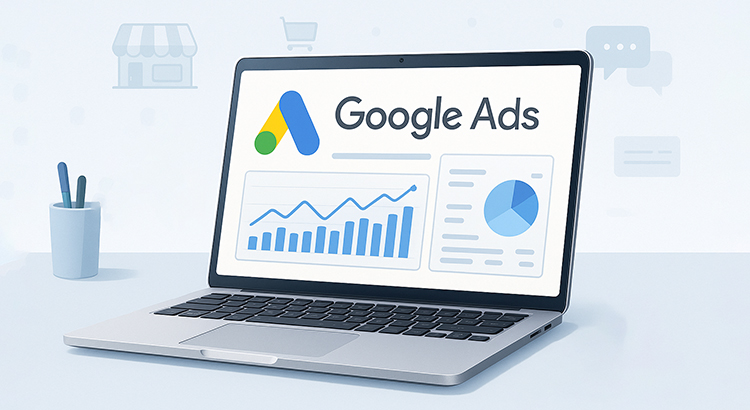Google Ads for small business offer a powerful way to reach potential customers online. This platform allows you to target specific audiences based on their interests and location. With the right approach, you can increase your visibility and attract more traffic to your website. Learning how to advertise on Google Ads effectively can help you grow your customer base and boost sales.
Benefits of Google Ads for Small Business
Here are the main advantages of using the paid advertising platform for small businesses.
1. Brings in High-Intent Leads and Customers
The paid advertising platform makes it possible to attract users who are already searching for your products or services. When campaigns are structured properly, they deliver highly relevant traffic to your site, contact forms, or sales pages. By narrowing in on specific keywords and audiences, you ensure that the clicks you pay for are more likely to convert into actual business.
2. Offers Flexible Marketing Options
One of the biggest advantages of this PPC ads platform is its adaptability. Whether you’re running a tight budget or testing different marketing ideas, you can adjust campaigns based on user location, device, or even the specific Google-owned property like YouTube or Maps. Budget control is another highlight, allowing you to set daily caps and bid limits tailored to your goals.
3. Delivers Solid Return on Investment
You only pay when someone interacts with your ad, making this platform one of the more cost-efficient advertising tools for small businesses. With continuous testing and analysis, you can refine your approach to focus on ads that yield the best results. Transparent metrics and detailed dashboards make it easier to evaluate campaign performance and maximize the value of your spend.
4. Provides Quick and Clear Insights
The PPC ads platform stands out for its real-time performance data. You’ll have access to valuable reports that show keyword performance, click-through rates, and spending patterns. This level of transparency helps small businesses make smarter decisions quickly and make the most of their advertising efforts.
5. Taps Into Large, High-Quality Traffic Pools
Because of the search engine’s dominance, this platform gives small businesses access to massive traffic volumes. More importantly, the system is designed to prioritize relevance. That means the users it sends to your site are not just random visitors but people with genuine interest in what you offer.
6. Reveals Market Insights That Drive Better Business Decisions
Beyond conversions, this advertising system offers insights into customer behavior that would be hard to gather elsewhere. From the keywords that bring users to your site to the devices and locations they come from, this data allows you to understand your market more deeply. These insights can shape not only your advertising strategy but also your products and services.
Steps to Google Ads for Small Business
Take a look at the following steps to help you create and manage effective campaigns on the paid advertising platform for your small business.
1. Choose the right keywords
Developing an effective keyword strategy is essential to making the most of your advertising budget and avoiding wasted spend. Instead of focusing only on the cheapest terms, try to find a balanced mix that includes both high-cost, high-reward keywords as well as branded or lower-cost phrases.
You can use free keyword research tools like Google’s Keyword Planner or similar tools to identify the terms that will work best for your campaigns.
2. Have a holistic Google strategy
Paid listings are just one part of your overall presence on Google. There are many free methods to appear on the first page, such as optimizing your Google Business Profile and creating blog content.
When your business appears in several spots on the search results page, it builds credibility and increases the chances that users will click on your paid advertisements. Make sure you cover the basics of SEO to appear in organic and local search results alongside your ads to boost your visibility.
3. Try the budget report
Keeping track of how you spend your budget on the paid advertising platform is important for meeting your business goals. The platform provides a budget report that is easy to access from different campaign views or your ad groups.
This report shows how much a campaign has spent so far and gives monthly forecasts for your total spend. It also helps you see how adjusting your daily budget may affect your campaign’s results.
4. Run Google Local Services Ads
If your business offers services, Local Services Ads can help connect you with relevant customers nearby. These ads are managed through your Google Business Profile, and you are charged only for qualified leads.
The system confirms the customer’s location and the type of service they need before putting them in touch with you, which makes these ads a practical choice for reaching local markets effectively.
5. Don’t neglect impressions
Many small business owners focus primarily on conversions, but impression share is also important, especially when building local awareness.
Use tools like Google Trends to find popular local search terms and include these in your campaigns on the PPC ads platform. Even if your ads mainly generate impressions at first, that visibility is valuable and can lead to future growth.
6. Remember dynamic keyword insertion and local terms
Dynamic keyword insertion or DKI automatically updates your ad headlines or descriptions to match what the searcher types in real time. Many small businesses use this feature to target multiple location names within their area easily.
If DKI is not a fit for you, make sure to include local language in your keywords and ad text, such as phrases like “near me.” Searches for terms like “near me” or “close by” have surged by over 900 percent in recent years, making them effective keywords to capture local intent.
7. Use geotargeting
A key element of local pay-per-click campaigns is geotargeting. While customizing your keywords and ad content for your market is important, geotargeting ensures your ads only appear in selected geographic areas.
This focused targeting helps you get the most out of your budget and increases your share of impressions in the locations where your business operates.
8. Run a SWOT analysis
Even with a local focus, you’ll be competing against other small businesses nearby as well as larger players. Performing a SWOT analysis allows you to understand your strengths, weaknesses, opportunities, and threats in comparison to competitors.
This insight helps you create ad messaging that targets unmet needs and highlights what makes your business stand out.
9. Drive traffic to your website
Having compelling ads is only part of the equation. If your ads do not bring visitors to your website, they cannot generate leads or sales. Start by focusing your efforts on increasing website traffic. For example, use top-of-funnel campaigns to build interest and encourage clicks.
Once visitors arrive on your site, make sure you have lead magnets or other tools to capture their information. As traffic grows and leads begin to flow, you can analyze this data to fine-tune your approach.
10. Always use ads with strong calls to action
Clear calls to action are crucial for converting clicks into leads. Your ad copy should qualify your audience and make the desired action obvious. When users understand exactly what you want them to do, they are more likely to engage.
The last thing you want is to pay for clicks from people who are unsure and then leave without converting. Always review your calls to action to ensure they use clear and persuasive language that encourages the next step.
11. Leverage ad extensions
Beyond driving visitors to your website, there are additional ways to increase leads through PPC campaigns. One effective method is using ad extensions on search ads. For instance, lead form extensions let users submit their information directly from the search results page.
Similarly, call extensions encourage phone inquiries right from the ad. Sitelinks, which add extra links below your main ad text, can boost lead generation by directing users to more pages on your site. You can even link these sitelinks to specific conversion points such as contact forms or purchase pages to improve results.
12. Perform regular audits
Ignoring your paid campaigns is not an option. Conducting frequent audits helps uncover opportunities to improve your return on investment. Without regular check-ins, you might experience unnoticed budget leaks or ineffective spending.
Make it a habit to review keyword costs, ad effectiveness, scheduling, and other factors to ensure your campaigns remain efficient.
13. Know your bidding strategy options
Your bidding approach can greatly impact the return on your advertising spend. Many automated bidding options exist that optimize for specific goals like cost per acquisition or return on ad spend. If you are not satisfied with your current results, your bidding strategy should be the first area to review.
You might be bidding too aggressively or too conservatively, which affects your ad placement and the quality of clicks or conversions you attract. For guidance, explore detailed comparisons of automated bidding options or watch tutorials available in training courses on the paid advertising platform.
14. Focus on lead generation first
It is common for small businesses to concentrate on immediate ROI when starting with paid campaigns. However, prioritizing lead generation over direct sales can deliver better returns over time.
The more leads you collect, the more opportunities you create to convert prospects and offset your costs in the long term.
15. Spend money to make money
If your bids or budgets are too low, your ads will not generate enough activity to provide meaningful data for optimization. To succeed with the paid advertising platform, you need to invest sufficiently in your campaigns.
If your cost per acquisition is initially high or your return on ad spend is low, avoid reducing your budget too soon. Early on, margins may be tight but with persistence and ongoing adjustments, your profitability can improve. Investing a reasonable budget in campaigns that are likely to convert is essential for growth.
16. Implement a multichannel strategy
To keep your customers engaged, it’s important to reach them across different channels. The platform now offers many options to advertise throughout the buyer’s journey, including Shopping, Display, Performance Max, and others.
Using a multichannel approach helps build longer-term campaigns like remarketing, which lets you maintain momentum even after you’ve reached your initial audience.
17. Invest in a CRM
A small business depends on strong internal processes. After generating leads through your paid campaigns, you need a way to track and nurture them to avoid missing opportunities. Customer relationship management software helps manage this, keeping customers engaged over time.
Additionally, it allows you to gather personal data that can be used to refine and personalize future advertising. A CRM also saves time, giving you more space to optimize your advertising account.
18. Keep track of the data
As your PPC campaigns grow, so does your historical data. Understanding the metrics that matter most to your business is key for making informed decisions. There are many free reporting tools available within the ad platform’s system as well as third-party options.
Find what fits your needs and establish a regular routine for reviewing performance to stay accountable and on track with your goals. It’s also important to benchmark your results against competitors by checking industry-specific advertising standards. This not only helps you stay competitive but also pushes you to improve continuously.
Wrapping Up
Google advertising for small business provides an effective path to connect with your target audience and achieve measurable results. By using the right strategies and tools, you can maximize your budget and drive valuable leads. Staying consistent with your efforts and continuously optimizing your campaigns will help your business grow steadily. Embracing this approach opens up new opportunities for success in the competitive online marketplace.


